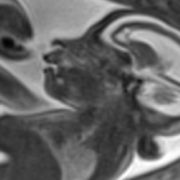MRI finds novel brain defects in Zika-exposed newborns

“Imaging is constantly helping us make new discoveries with this virus, and in these two cases we found things that had not been previously described,” says Sarah Mulkey, M.D., Ph.D.
Magnetic resonance imaging (MRI) has identified two brain abnormalities never before reported in newborns with prenatal exposure to the Zika virus. Children’s National Health System researchers reported these findings from a study of more than 70 fetuses or newborns with Zika exposure in utero. The study was published in the January 2018 edition of Pediatric Neurology.
The two novel defects – cranial nerve enhancement and cerebral infarction – may join the growing list of neurological findings associated with congenital Zika infection.
“Imaging is constantly helping us make new discoveries with this virus, and in these two cases we found things that had not been previously described,” says Sarah Mulkey, M.D., Ph.D., the study’s lead author and a fetal-neonatal neurologist at Children’s National. Dr. Mulkey works in Children’s Congenital Zika Virus Program, one of the nation’s first comprehensive, dedicated Zika programs.
The research team recommends that postnatal brain MRI be considered in addition to ultrasound for newborns exposed to Zika in utero. “Brain MRI can be performed in the newborn often without sedation and provides an opportunity to look for brain abnormalities we might not catch otherwise – or might not detect until much later,” says Dr. Mulkey.
Birth defects are seen in 6 to 11 percent of pregnancies affected by Zika, and some of the neurological complications in infants are not apparent until well after birth.
Of the two infants in which the new abnormalities were observed, both had normal head size at birth. Neither had smaller-than-normal head size (microcephaly), one of the more severe effects associated with congenital Zika syndrome.
One infant had a normal neurological evaluation at 2 days of age. However, a brain MRI conducted the following day, using gadolinium contrast due to concern of infection, showed enhancement of multiple cranial nerves. “Nerve root enhancement is very rare in a newborn and had not been described with Zika before,” Dr. Mulkey says. “Yet, there was no neurological deficit that we could identify by physical exam.”
The research team acknowledges that the clinical significance of this finding is not yet known.
In the second patient, brain MRI conducted without contrast at 16 days of age revealed a small area consistent with chronic infarction (ischemic stroke) that likely occurred during the third trimester.
“We followed the mother throughout her pregnancy, and both MRI and ultrasound imaging were normal at 28 weeks gestation,” Dr. Mulkey says. “A postnatal ultrasound was also normal, but the postnatal MRI showed a stroke that had occurred at least one month prior to the MRI and after the last fetal study.”
She adds: “This is the first published report of fetal stroke associated with Zika infection, and it may add to our knowledge of what can occur with congenital Zika infection.”
Unlike most congenital infections, Zika virus does not appear to cause viral-induced placental inflammation, which can lead to fetal stroke. So, the authors say they cannot be sure that congenital Zika contributed to the infarct in this case. However, they write, “Given the relatively low incidence of perinatal ischemic infarct and the lack of other maternal- or birth-related risk factors for this patient, Zika infection is considered a possible etiology.”
In both patients, neonatal brain MRI identified subclinical findings that had not previously been described as part of congenital Zika syndrome. As the body of evidence about the Zika virus has grown, the spectrum of associated brain abnormalities has expanded to include considerably more findings than isolated microcephaly.
Data gathered in 2017 from the Centers for Disease Control and Prevention’s Zika pregnancy and infant registry indicates that 25 percent of eligible U.S. infants receive recommended postnatal imaging. Dr. Mulkey said this represents many possible missed opportunities for earlier identification of brain abnormalities.
“Brain MRI should be considered in all newborns exposed to Zika virus in utero, even in the presence of normal birth head circumference, normal cranial ultrasound and normal fetal imaging,” she says. “In both of these patients, the changes we observed were not evident on cranial ultrasound or on fetal MRI and fetal ultrasound.”
In addition to Dr. Mulkey, Children’s co-authors include L. Gilbert Vezina, M.D., Neuroradiology Program director; Dorothy I. Bulas, M.D., chief of Diagnostic Imaging and Radiology; Zarir Khademian, M.D., radiologist; Anna Blask, M.D., radiologist; Youssef A. Kousa, M.S., D.O., Ph.D., child neurology fellow; Lindsay Pesacreta, FNP; Adré J. du Plessis, M.B.Ch.B., M.P.H., Fetal Medicine Institute director; and Roberta L. DeBiasi, M.D., M.S., senior author and Pediatric Infectious Disease division chief; and Caitlin Cristante, B.S.
Financial support for this research was provided by the Thrasher Research Fund.















